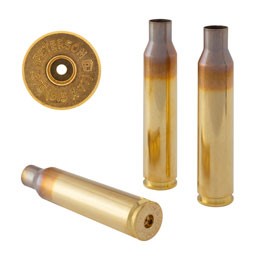How Peterson’s CheyTac® Caliber Casings Compare
When we set out to develop the tooling to manufacture brass rifle casings in the two popular CheyTac® calibers (.408 CHEYTAC and .375 CHEYTAC) we set a number of goals for ourselves. We had heard all the complaints about the existing casings on the market and knew we had to resolve each of those issues with our casings.
Correct Hardness
Sticking in the chamber after firing, neck splits, and case-head separation are all a function of improper hardness along the casing wall. Casings need to be hardest down at the head. If it isn’t the correct hardness there it contributes to primers blowing out and or gas leak around the primer during firing.
Casings need to be softest at the mouth and neck. Otherwise the neck tension can be wrong, and or the neck will split when the projectile is inserted. In the middle of the tube the hardness needs to be at a different value to prevent case-head separation and or sticking in the gun after firing.
Not all casing manufacturers have the equipment or ability to dial up or down the hardness values at the different locations. But we do. And we did. And our casings don’t have the problems associated with incorrect hardness.
Dimensionally consistent
Another common complaint we heard about the other guys was irregular size and shape from casing to casing. That issue was the easiest for us to solve. With all the casings we make in any caliber, we perform a battery of in-process, real-time dimensional checks. There are 11 different dimensions we test for continuously throughout each shift. Some of these are Tube cylindricity, mouth to body concentricity, primer pocket diameter, length to shoulder, overall length, etc. These measurements are automatically fed into Statistical Process Control software. If a dimension begins to drift from nominal we can catch it immediately and correct it.
Fit the different chambers
Because there is no SAAMI spec for these calibers, guns with different size chambers have been produced over the years. Many guns chambered in the CheyTac® calibers have been made with Pacific Tool chamber reamers. JGS also makes chamber reamers for these calibers but they produce a chamber slightly different than the Pacific Tool chambers. CheyTac® caliber guns made in Europe are made to a third size.
Our goal was to produce a casing that will chamber in guns made to any of these three sizes. We believe we have.
Availability
Peterson Cartridge purchased additional manufacturing equipment designed specifically to produce these large casings. Our capacity is 5-million casings a year (400,000 casings a month). We are committed to there not being a shortage of these calibers ever again.
Price stability
Because CheyTac® caliber casings have been frequently in short supply the price sometimes spikes up unreasonably high. We are committed to keeping the price of our casings stable – year in and year out. We only intend to move up or down based on a change in the price of brass. Our prices are based on the volume purchased. The higher the volume the lower the price.
CheyTac® is a registered trademark of CheyTac USA, LLC. Peterson Cartridge is not affiliated with, endorsed by or sponsored by CheyTac USA.
